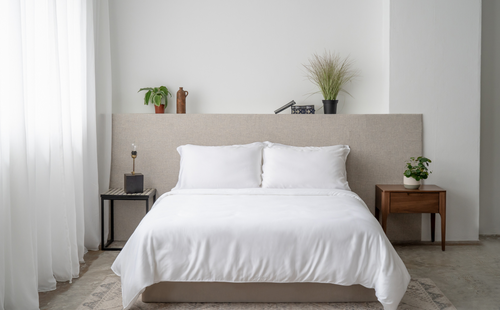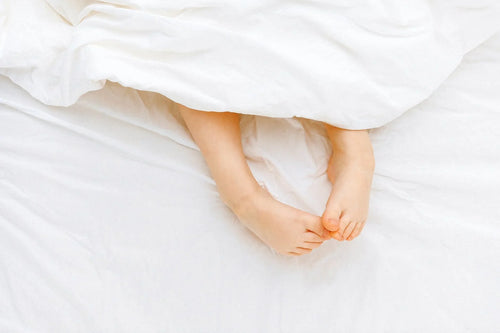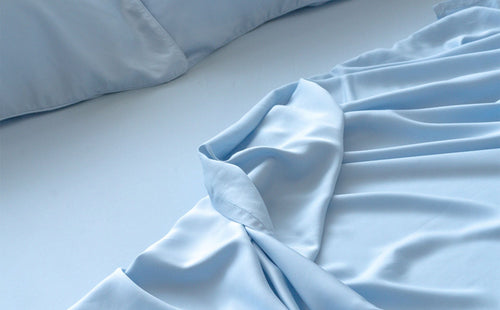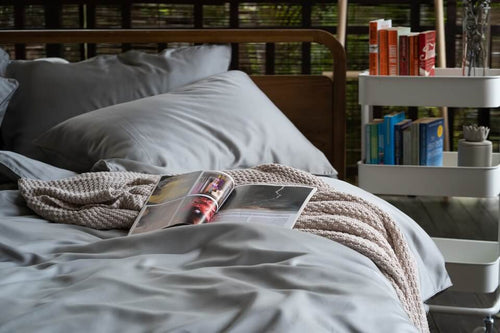At a Glance
Tired of always sleeping hot and stuffy? We have a list of the best cooling bed sheet materials to help you achieve uninterrupted sleep!
Quick Tips
- Ideally, your sleeping temperature should be between 18°C to 26°C.
- Weave type, thread count, etc. all help determine the sheet's cooling ability.
Waking up feeling hot and restless is something many of us can relate to. While air conditioning offers some relief, it’s not always the most energy-efficient or budget-friendly option. That’s where cooling bed sheets come in.
They provide a more cost-effective solution, made from breathable, moisture-wicking materials like cotton, TENCEL™, or bamboo. These sheets help regulate your body temperature and draw heat away, keeping you cooler throughout the night.
In this article, we’ll explore the best materials for staying cool in bed and why more people are turning to moisture-wicking sheets for a more comfortable sleep.
Best Cooling Bed Sheet Material Comparison
|
Material |
Cooling Ability |
Moisture-Wicking |
Breathability |
Eco-Friendly |
Durability |
|
Cotton |
Moderate, depends on weave |
Moderate |
Good |
Low |
Good |
|
Bamboo |
High, reduces trapped heat |
High |
Very good |
Moderate |
Fair |
|
TENCEL™ Lyocell |
Very high, best cooling performance |
Excellent |
Excellent |
High |
Excellent |
1. Cotton Bed Sheets
Cotton fabrics have long been a classic choice for various purposes, including clothing and bed linen. The term “Egyptian cotton” is also frequently mentioned when selecting high-quality cotton fabric. However, this raises the question: Do cotton fibres generally possess cooling properties?
Cotton is naturally breathable, and its cooling abilities can be further enhanced by its weave method. Typically, percale and sateen weaves are ideal for cooling, soft sheets, as they are more breathable and lightweight. Cotton sateen sheets are slightly heavier than percale sheets due to their complex weave structure, but they are more wrinkle-resistant and quieter, thanks to their silkier texture compared to the crisp feel of percale sheets.
Unfortunately, cotton is the least eco-friendly option, as its cultivation method contributes to significant ecosystem damage worldwide. Other sustainable alternatives, such as bamboo and TENCEL™, provide the same cooling effects without causing much harm to the environment.
Featuring Weavve’s Cotton Fitted Sheet
2. Bamboo Bed Sheets
Bamboo fibres also have desirable qualities when it comes to making cooling sheets. They are more breathable, softer, and more flexible than cotton. Additionally, bamboo fibres are naturally antibacterial and antifungal, which is an added perk.
So, what makes bamboo sheets cooling? A study observing the fibre’s performance in warmer temperatures showed that they efficiently reduce the heat trapped in your body. This is reflected in the fibre’s low thermal resistance compared to cotton and TENCEL™, helping to lower your core body temperature.
Although bamboo fibres are considered relatively eco-friendly and more so than cotton, their treatment processes can involve harmful chemicals such as sulfuric acid and carbon disulfide. Moreover, bamboo sheets have the highest rate of shrinkage among the three materials and are prone to wrinkles and pilling over time.

Image By 8photo From Freepik
3. TENCEL™ Bed Sheets
Last but certainly not least are eucalyptus Lyocell sheets that are made with TENCEL™ fibres by Lenzing AG. TENCEL™ Lyocell fibres are their latest generation of fibres by Lenzing AG and are also the coolest fibre type produced by them.
A study comparing the comfort properties of different fibres found that 100% TENCEL™ Lyocell fibres in comparison to bamboo rayon and cotton were the most breathable. Additionally, they have temperature-regulating properties that greatly contribute to their suitability for making the best cooling sheets.
Their ability to effectively regulate temperature is a result of how excellent they are at managing moisture. This is due to the structure of the natural fibres, which can easily absorb and release excess moisture, thus lowering your body temperature and keeping hot sleepers sweat-free.
Featuring Weavve’s Signature TENCEL™ King Bed Sheets In Stone White
Moreover, TENCEL™ Lyocell fabrics are durable and have a higher tear resistance than cotton and bamboo fabrics as well. The smooth surface area of the fibres allows for a silky smooth and soft feel, which results in it being extra gentle and ideal for sensitive skin as well.
Furthermore, the rate of bacterial growth is 10 times slower in comparison to bamboo and cotton fibres, as their effective moisture management properties create unsuitable conditions for bacteria to grow.
From an eco-friendly perspective, TENCEL™ Lyocell fibres are also the most environmentally friendly as they are sustainably harvested following the guidelines of the Lenzing Wood and Pulp Policy and are (USDA) BioPreferred®.
While TENCEL™ Lyocell bed sheets are generally pricier than cotton and bamboo sheets due to the cost of their production processes, they are worth the investment for comfortable, cooling sleep.
What Properties Make A Cooling Bed Sheet?
There are a number of factors that determine how cool your sheets will feel, namely: type of material, breathability, moisture absorbency, weave type, and thread count.
1. Moisture-Wicking Abilities
A sheet’s moisture-wicking abilities will determine how much it can keep you feeling fresh and free of night sweats during your sleep. This property is also a key factor in temperature-regulating sheets, as the ability to remove excess moisture will help lower your body temperature.
2. Breathability
Following the factor of moisture absorbency, cool wicking sheets may manage moisture well but they are not always breathable which could induce your night sweats. As our bodies naturally regulate our temperature by sweating out the heat, this would be hard to do with less breathable sheets.
Featuring Weavve’s Signature TENCEL™ Queen Bed Sheets In Stone White
3. Type Of Weave
The weave method of sheets not only affects the appearance but also the skin feel on how cooling the sheets can be. For instance, can give off different skin contact feels due to their difference in weave method.
4. Thread Count
Thread count also plays a key role in how cool your sheets can get, as higher thread count sheets trap heat. The National Sleep Foundation recommends bed sheets with a thread count of 200 to 400, depending on the cotton type.
However, it also should be noted that thread count is not the largest determining factor on whether a sheet is of good quality. Some manufacturers also have a tendency to bump up the thread count by using multi-ply and lower-quality threads.
5. Bed Sheet Material
Now that we’ve covered all the factors that contribute to a cooling bedsheet, it all comes down to the material. The type of sheets you choose will depend on your preferences, but with the properties of cotton, bamboo, and TENCEL™ fibres already discussed, you now understand what makes a cooling bed sheet.
Featuring Weavve’s Signature TENCEL™ Classic Set
How Temperature Affects Sleep & Ideal Temperature For Sleep
A study carried out by the International Journal of Environmental Research and Public Health showed that sleep environment temperature affected sleep satisfaction, sleep calmness, and the ease of falling asleep. More specifically, it reflected that higher bedroom temperatures often led to a higher chance of disrupted sleep as well as an overall decrease in sleep quality.
This was because we produce more stress hormones (cortisol) in hotter temperatures. Additionally, sleeping hot can also decrease the time spent in REM sleep, which negatively affects the body’s immune system as well as lessen memory and learning abilities.
Furthermore, it is harder to fall asleep in higher temperatures as our bodies naturally have a “body clock” called the circadian rhythm, which regulates our sleep and wake times.
This rhythm is influenced by a few main factors, such as the exposure to light, the temperature of our surroundings, and our level of physical activity. In higher temperatures, your body tends to be more alert, which makes it harder to fall asleep when you are feeling hot.
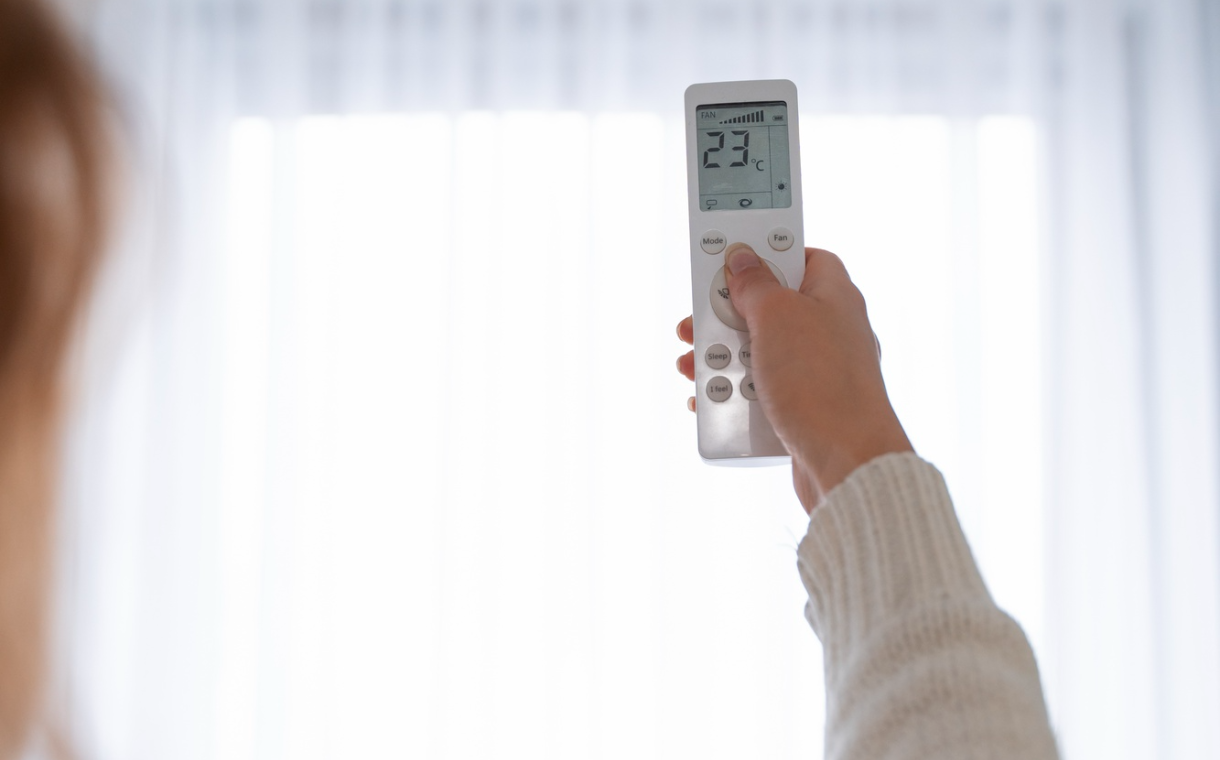
Image From Freepik
What Is The Ideal Temperature For Sleep?
The ideal sleep temperature varies for everyone; there is no single "perfect sleeping temperature." However, the National Sleep Foundation suggests that the optimum sleeping temperature falls between 18°C and 26°C.
As mentioned earlier, such a temperature range is rare in Singapore’s climate at night, particularly during the summer months. The most common solution for cooling your room is air conditioning, but it can be costly and harmful to the environment with frequent use. Additionally, relying on air conditioning often means missing out on natural air ventilation, which can affect your sleep quality.
Cool-wicking sheets are not only great for keeping you cool during warmer weather but also help improve your sleep quality when you can’t use air conditioning on stuffy nights or when you're dealing with congestion and allergies.
These breathable, moisture-wicking materials like TENCEL™ help regulate your body temperature and provide comfort throughout the year, creating a more restful environment.
Tried & Tested: Honest Reviews On Cooling Bedsheets
Weavve’s TENCEL™ bed sheets provide the perfect foundation for a peaceful night’s sleep. Naturally cool to the touch, they’re wonderfully soft, kind to sensitive skin, and packed with antibacterial properties. These sheets also excel at moisture-wicking, keeping you comfortable and regulating your body temperature throughout the night.
In a cooling test comparing TENCEL™ to cotton and linen, TENCEL™ took the lead, delivering the best cooling performance of all.
“I love these sheets so much! Bought two sets, one was the mauvey purple and the other was the grey. They are super comfortable to sleep in; they keep you cool but also ensure they trap enough heat. Very happy with my purchases! Will buy more when other colours come out too.”
- Rebecca N.
“This is our 2nd purchase as the cooling, smooth texture of the bedsheet set helps us to have a good night's sleep.”
- Grace T.
“I've already lost count of the number of times I bought the TENCEL™ sets from Weavve Home. Better than hotel quality, cooling, and will make your sleep more sound. No regrets with all my purchases.”
- Kok C.

Frequently Asked Questions
What Is A Wicking Sheet?
A cool wicking sheet is designed to keep you cool and dry during sleep by managing moisture. It draws sweat away from your skin and distributes it across the surface of the fabric, enabling fast evaporation. This process helps to regulate your body temperature and keeps you from feeling uncomfortable or overheated.
What Is The Most Wicking Fabric?
TENCEL™ Lyocell stands out as a top moisture-wicking fabric. Made from sustainably sourced wood pulp, it efficiently draws moisture away from the skin, keeping you cool and dry all night. With breathable fibres that promote fast evaporation, TENCEL™ is ideal for regulating body temperature and ensuring comfort.
What Sheets Keep You Cool Are Wicking And Comfortable?
For a truly refreshing night’s sleep, opt for sheets that keep you cool, wick away moisture, and feel comfortable. Fabrics like TENCEL™, bamboo, and cotton are ideal choices. To make the most of these cooling sheets, go for the right thread count, wash them regularly to keep them soft, and combine them with other bedding, such as a duvet and flat sheet, to optimise comfort.
Do Hotels Use Cooling Sheets?
Yes, many hotels use cooling bedsheets to enhance guest comfort, especially in warmer climates or during the summer months.
What Is The Difference Between Cooling Sheets And Regular Sheets?
Cooling sheets are crafted from breathable, moisture-wicking fabrics that actively regulate your body temperature, helping you stay cool all night long. In contrast, regular sheets, typically made from polyester blends, lack these breathable and moisture-wicking qualities, leaving you feeling hotter and more uncomfortable as you sleep.
Conclusion
Choosing the right bedding can make a big difference to your sleep quality, especially if you tend to sleep hot. Cool wicking sheets provide a cost-effective way to stay comfortable at night without relying on air conditioning.
A good cooling bedsheet helps you stay dry, regulate your temperature, and enjoy a more restful sleep all year round.































